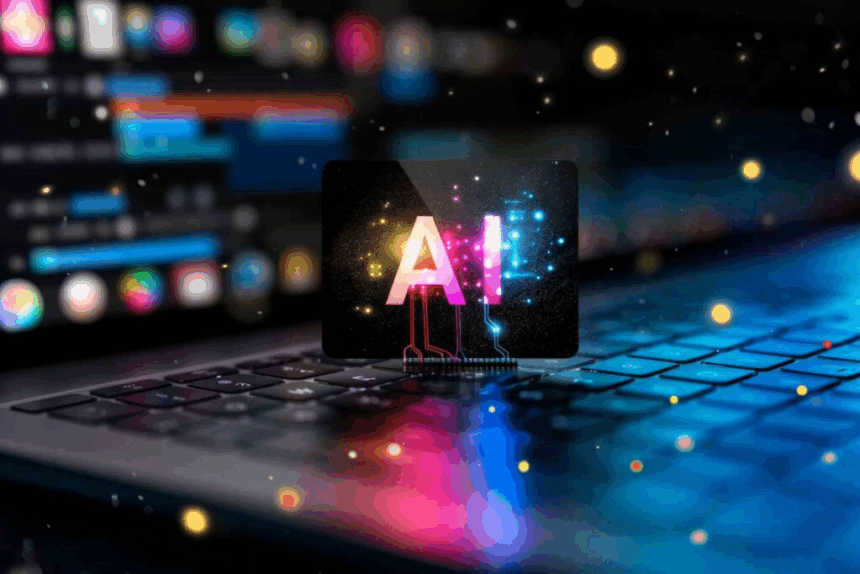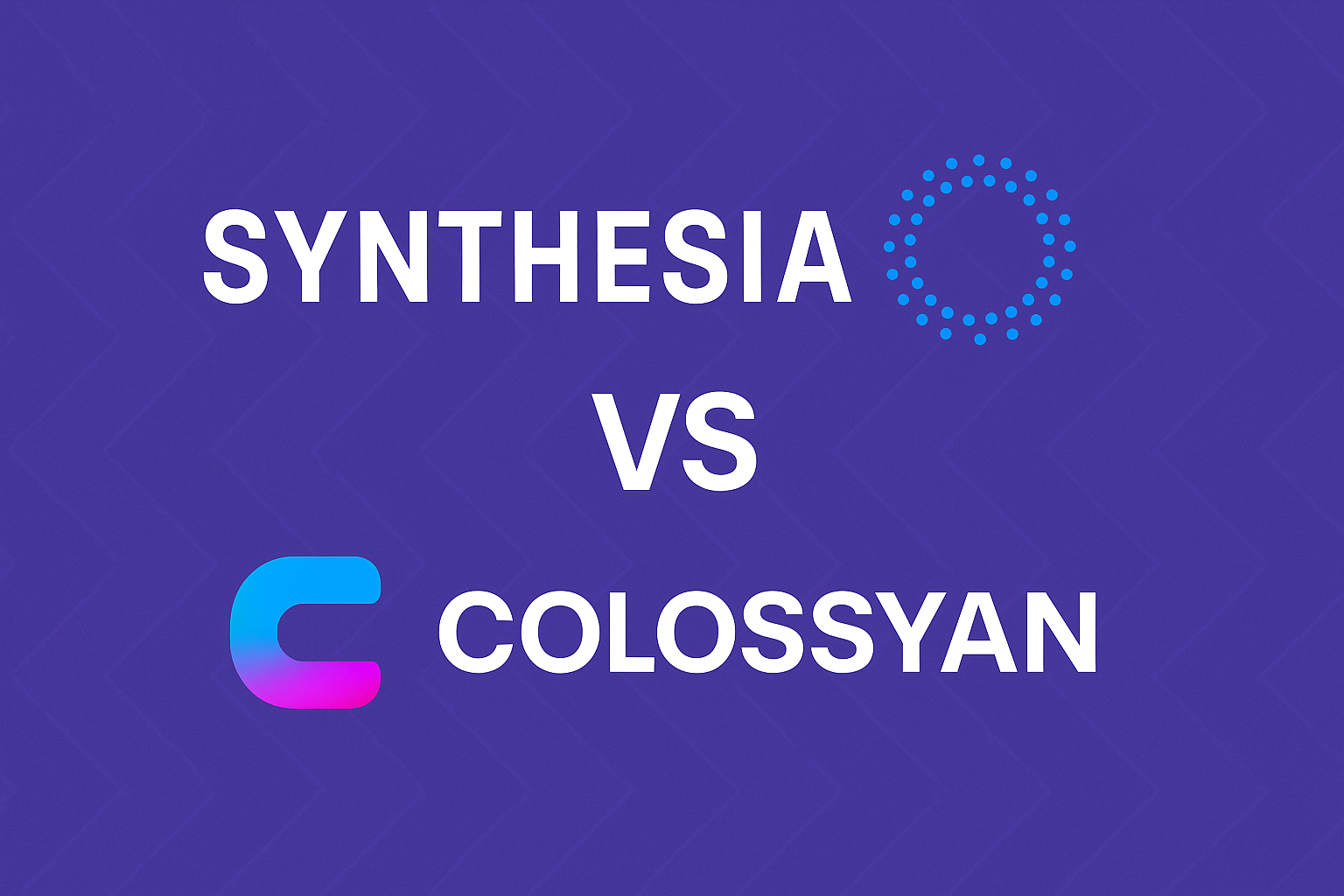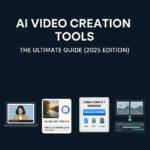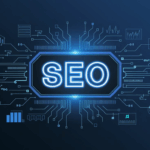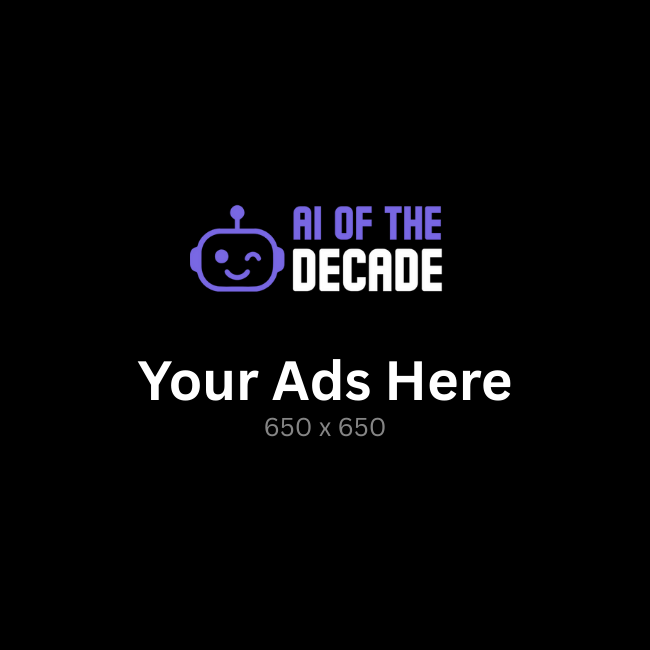The world of design has changed forever. Once upon a time, businesses relied entirely on expensive graphic designers, creative agencies, and long project timelines to produce logos, social media creatives, and branding assets. Today, thanks to the rapid rise of AI design tools, the landscape is more accessible, faster, and more innovative than ever.
AI design tools use machine learning algorithms and large-scale models to generate visuals, logos, branding materials, and even full UI/UX prototypes. These tools aren’t just gimmicks; they are reshaping how businesses, startups, and individual creators approach creativity.
In 2025, the best AI design tools can:
- Convert text prompts into detailed graphics
- Suggest design templates and color palettes
- Create business-ready branding kits in minutes
- Automate repetitive design tasks like resizing and formatting
- Make professional-quality design accessible to non-designers
This guide will take you through 20+ of the best AI design tools available in 2025, with detailed reviews, business use cases, pricing insights, and practical comparisons to help you choose the right one for your workflow.
Why Use AI Design Tools?
The adoption of AI design tools isn’t just a passing trend — it’s a full-blown business necessity. Here’s why companies, marketers, and even professional designers are embracing AI in design.
1. Speed & Efficiency
Traditional design workflows can take days or weeks. With AI, businesses can generate logos, social posts, or UI prototypes in minutes. For fast-moving industries like e-commerce and SaaS, this speed means you can test and publish creatives instantly.
2. Cost Savings
Hiring a designer or agency for every single banner, social media graphic, or logo variation is expensive. AI tools cut these costs by automating design generation — allowing businesses to allocate budget to higher-level creative strategy.
3. Creativity on Demand
Even seasoned designers hit creative blocks. AI design tools provide endless variations and ideas, giving you a starting point for new projects. For businesses, this means you can always keep content fresh.
4. Accessibility for Non-Designers
Not every startup has a design team. AI levels the playing field by allowing non-designers (founders, marketers, even sales reps) to produce professional visuals with no prior design knowledge.
5. Scalability
Imagine creating 100 ad variations, each optimized for different demographics or platforms. AI makes this possible, ensuring you can scale campaigns without overloading your team.
Key Features to Look for in AI Design Tools
Not all AI design software is created equal. When choosing the right tool for your business, pay attention to these key features:
- Text-to-Image Generation: Convert written prompts into custom visuals.
- Brand Kits & Logo Creation: AI-generated logos, fonts, and color palettes.
- UI/UX Prototyping: Generate wireframes and layouts automatically.
- Design Suggestions: AI-based recommendations for typography, layouts, and patterns.
- Collaboration Tools: Shared workspaces for teams and agencies.
- Integrations: Compatibility with tools like Figma, Canva, and Adobe.
The Best AI Design Tools in 2025 (Detailed Reviews)
1. Canva (Magic Design AI)

Canva has been the go-to design tool for non-designers for years, and in 2025 it continues to dominate thanks to its Magic Design AI update. What makes Canva so powerful is its accessibility. You don’t need to know complex tools like Photoshop; instead, you can simply input your idea, and Canva transforms it into visually appealing designs. With Magic Design AI, the process has become even faster. Enter a prompt like “Create a modern LinkedIn post for a SaaS company” and Canva will instantly generate branded templates ready for customization.
Key Features
- Magic Design: AI-driven prompt-to-template generation.
- AI background remover and photo editor.
- Brand Kit: upload your logo, fonts, and colors for instant brand consistency.
- Social media scheduler built into the platform.
- Team collaboration features for businesses.
Pros
- Extremely easy to use.
- Affordable for startups and small businesses.
- Thousands of ready-made templates.
- Great for social media content.
Cons
- Outputs can look “templated.”
- Limited creative flexibility compared to Adobe Firefly or MidJourney.
Best Business Use Cases
- Startups creating pitch decks, branded social posts, and investor presentations.
- E-commerce companies designing Instagram ads, product banners, and promo videos.
- Marketing teams producing hundreds of creatives per month without overloading designers.
Pricing
- Free plan available.
- Pro plan at $14.99/month.
2. Adobe Firefly
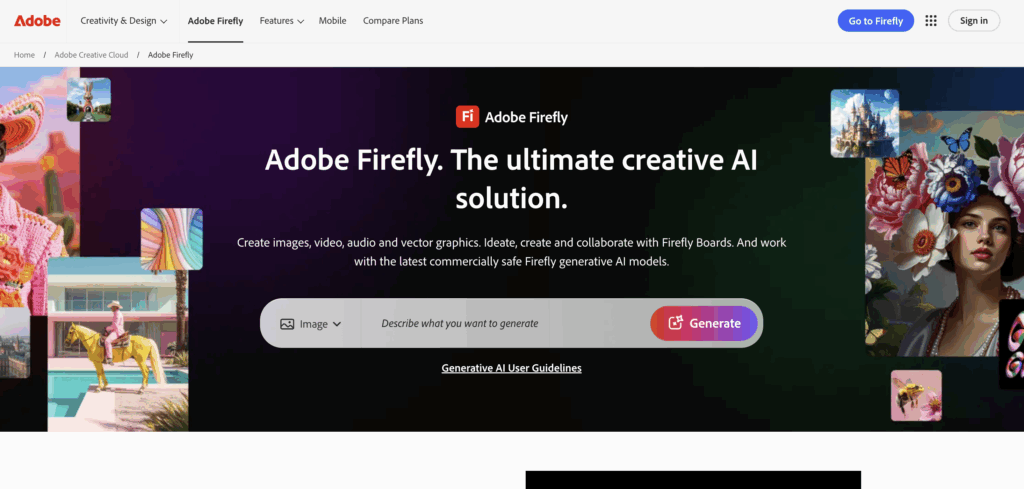
Adobe has long been the industry standard for professional design, and its Firefly AI suite represents a huge leap forward. Unlike Canva, Firefly is aimed at design professionals and agencies. It integrates directly into Photoshop and Illustrator, giving creatives tools like generative fill, text-to-image generation, and advanced color manipulation. For businesses that demand professional quality and originality, Firefly is a must-have.
Key Features
- Generative Fill: add/remove objects with natural prompts.
- Text-to-image and text effect generation.
- AI-driven color palette suggestions.
- Works seamlessly within Adobe Creative Cloud.
Pros
- Professional-grade AI quality.
- Ideal for advanced design workflows.
- Integrates with the Adobe ecosystem (Photoshop, Illustrator).
Cons
- Expensive for small teams.
- Requires design knowledge to unlock full potential.
Best Business Use Cases
- Advertising agencies generating polished marketing campaigns.
- Fashion brands editing catalogue images and product visuals.
- Large enterprises creating corporate ad assets at scale.
Pricing
- Part of Adobe Creative Cloud.
- Starts at $22.99/month.
3. Figma AI
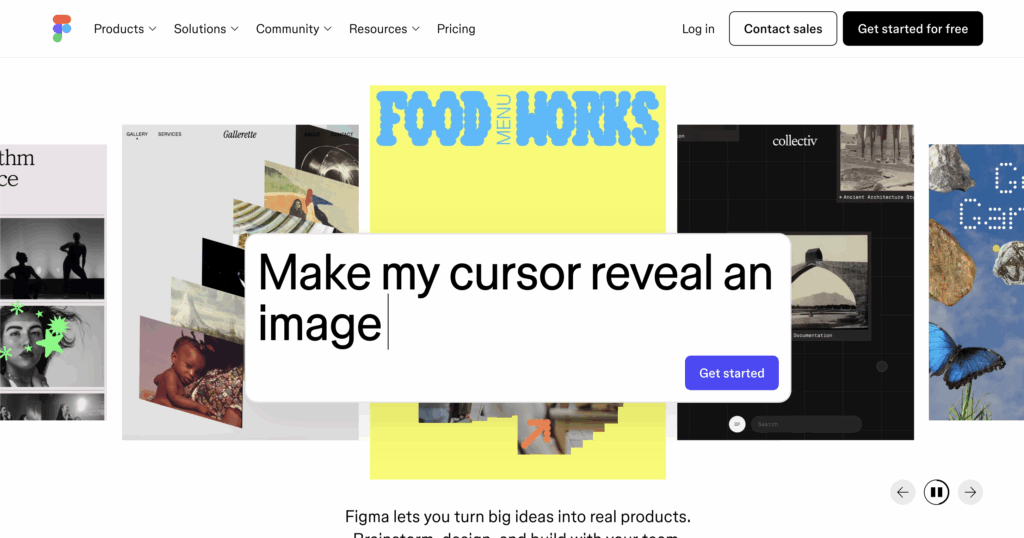
Figma is the go-to platform for UI/UX design and product teams, and with its new AI assistant, it’s even faster to go from idea to prototype. Figma AI can generate wireframes, suggest layouts, and even create content for mockups. For businesses building apps, websites, or digital platforms, Figma’s AI support reduces prototyping timelines from weeks to hours.
Key Features
- Auto-generate UI wireframes.
- AI suggestions for layouts and components.
- Collaborative cloud workspace.
- Integration with developer handoff tools.
Pros
- Speeds up product design workflows.
- Great for collaboration across teams.
- Saves weeks during early-stage development.
Cons
- Not useful for general graphic design.
- Learning curve for non-designers.
Best Business Use Cases
- SaaS startups prototyping new products.
- E-commerce brands testing mobile shopping flows.
- Enterprises running design sprints and product workshops.
Pricing
- Free basic plan.
- Pro plan at $12/month.
4. Looka
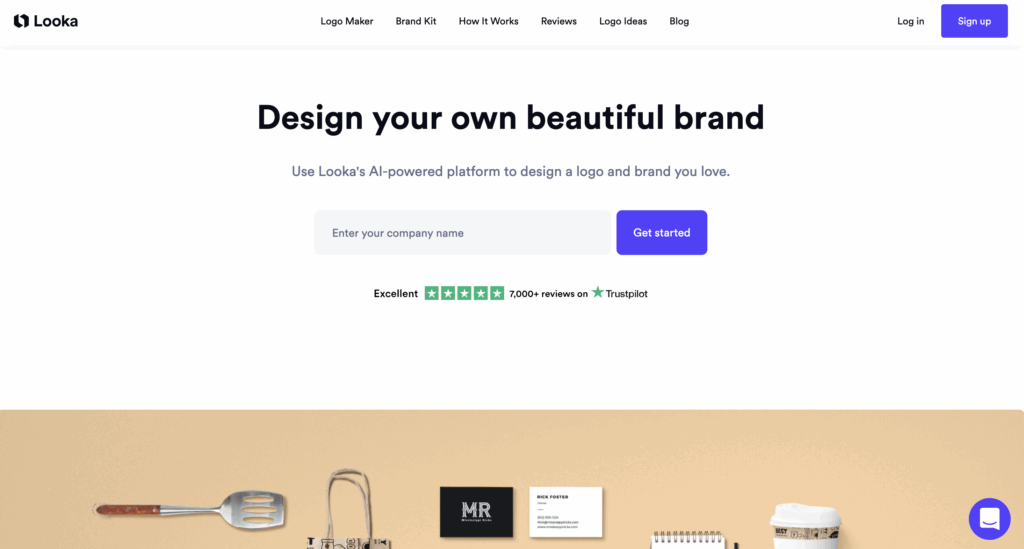
Looka is an AI-powered logo and brand identity generator designed for entrepreneurs and small businesses. Instead of paying thousands to agencies, Looka lets you create professional logos and complete brand kits in minutes. Simply input your company name, industry, and style preferences, and Looka generates options that can be edited and applied to real-world materials.
Key Features
- AI logo generator with style customization.
- Brand Kit: logos, color palettes, fonts.
- Marketing materials like business cards and social banners.
- One-time pricing for logo ownership.
Pros
- Affordable compared to custom designers.
- Fast — logos and kits ready in under an hour.
- Easy to use, no design knowledge required.
Cons
- Limited uniqueness compared to custom branding.
- Not suited for enterprises needing full originality.
Best Business Use Cases
- Cafés, gyms, and local shops building brand identity.
- Startups creating investor-ready branding in days.
- E-commerce businesses needing logos and color palettes for online stores.
Pricing
- Logo package: from $20 one-time.
- Brand Kit subscription: from $96/year.
5. Designs.ai
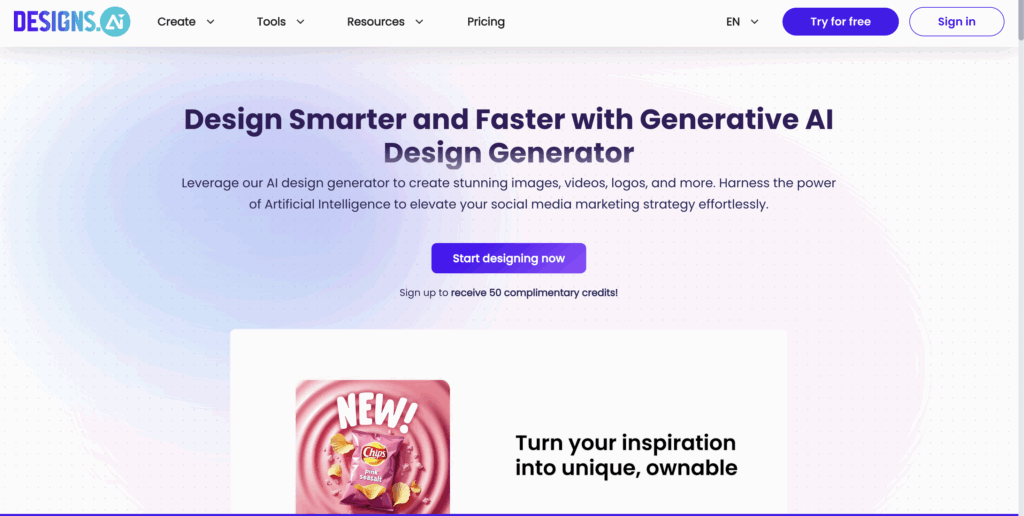
Designs.ai is a creative AI suite covering not just design, but also video, logo, and content creation. It’s ideal for small teams and marketing agencies that want everything under one roof. Instead of managing multiple tools, you can use Designs.ai to create a complete campaign — from logos and brand assets to promo videos and ad copy.
Key Features
- AI logo maker with branding kits.
- Video generator with stock media integration.
- AI-powered copywriting tool.
- Social media post templates.
Pros
- Multi-format support (logos, videos, posts).
- Saves agencies time by centralizing workflows.
- Simple, beginner-friendly interface.
Cons
- Quality not as advanced as dedicated pro tools.
- Can feel “generic” if heavily template-based.
Best Business Use Cases
- Agencies creating campaign kits for clients.
- Startups needing both design and copy quickly.
- Small businesses producing ads, logos, and videos without external help.
Pricing
Starts at $29/month.
6. Khroma
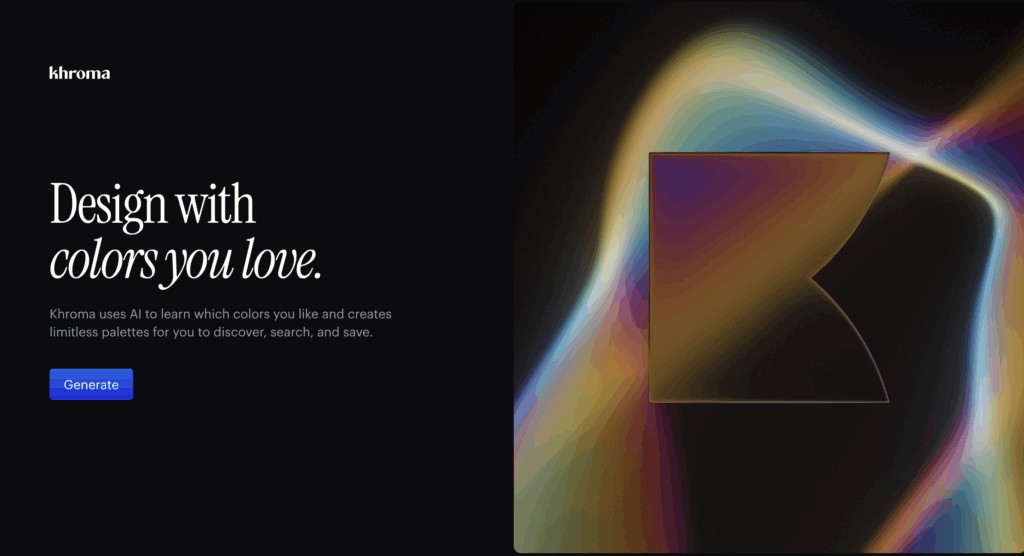
Khroma is a niche but powerful AI tool focused on color palette generation. For many businesses, branding success depends heavily on using the right colors that resonate with their target audience. Khroma helps designers, marketers, and startups create color systems that are not just aesthetically pleasing but also grounded in psychology and usability.
Key Features
- Learns from your favorite color choices and generates palettes accordingly.
- Offers contrast testing for accessibility compliance.
- Can be integrated into design projects with exportable codes.
- AI-driven palette suggestions tailored to industries (tech, fashion, wellness, etc.).
Pros
- Saves hours of experimentation with color schemes.
- Produces palettes aligned with modern design trends.
- Great for non-designers who struggle with color theory.
Cons
- Focused only on color (not a complete design suite).
- Not as useful for one-off quick designs.
Best Business Use Cases
- Startups designing logos and websites with consistent color branding.
- Marketing teams generating ad creatives that resonate with audiences.
- Agencies working on multi-client branding projects needing quick, tested palettes.
Pricing
Free.
7. Uizard
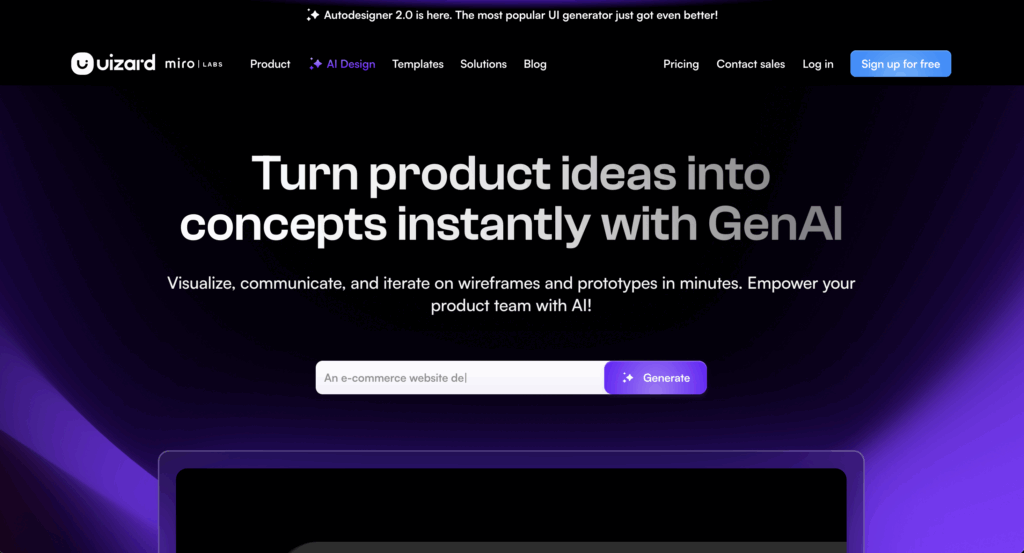
Uizard is an AI-powered UI/UX prototyping tool that converts text prompts into wireframes and mockups. It is perfect for founders, product managers, and startups who need to quickly visualize ideas without waiting on a design team.
Key Features
- Prompt-to-wireframe generation.
- Drag-and-drop UI customization.
- Conversion of sketches/photos into digital mockups.
- Collaboration features for product teams.
Pros
- Beginner-friendly, no design background needed.
- Speeds up product ideation.
- Affordable compared to full design teams.
Cons
- Limited compared to Figma for advanced prototyping.
- Customization options are basic.
Best Business Use Cases
- SaaS startups needing quick MVP mockups.
- Pitch decks showing app prototypes to investors.
- UX agencies brainstorming early wireframe options for clients.
Pricing
Free plan available; Pro from $19/month.
8. AutoDraw
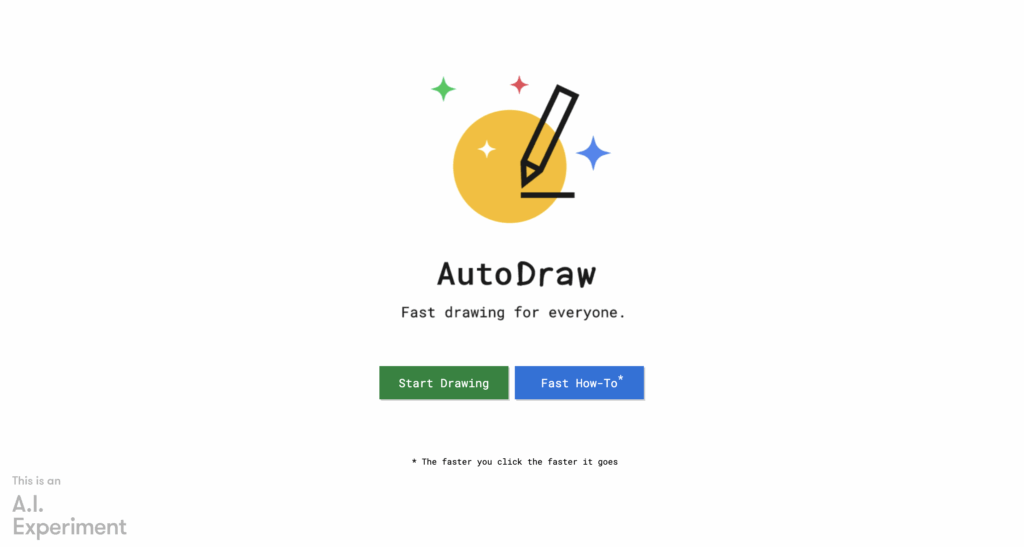
AutoDraw, created by Google, is a quirky but practical tool that transforms rough sketches into clean vector drawings. It’s powered by machine learning that guesses what you’re trying to draw and refines it into a usable design.
Key Features
- AI sketch recognition.
- Large library of clean vector icons.
- Fast brainstorming support.
- Simple export options for use in projects.
Pros
- Free and fun to use.
- Helps non-artists create usable visuals.
- Great for quick ideas in meetings and brainstorming sessions.
Cons
- Limited to icons and sketches.
- Not suitable for high-end design.
Best Business Use Cases
- Startups building whiteboard mockups for presentations.
- Teams needing quick icons for slides and diagrams.
- Agencies running workshops where visuals spark creativity.
Pricing
Free.
9. Kittl
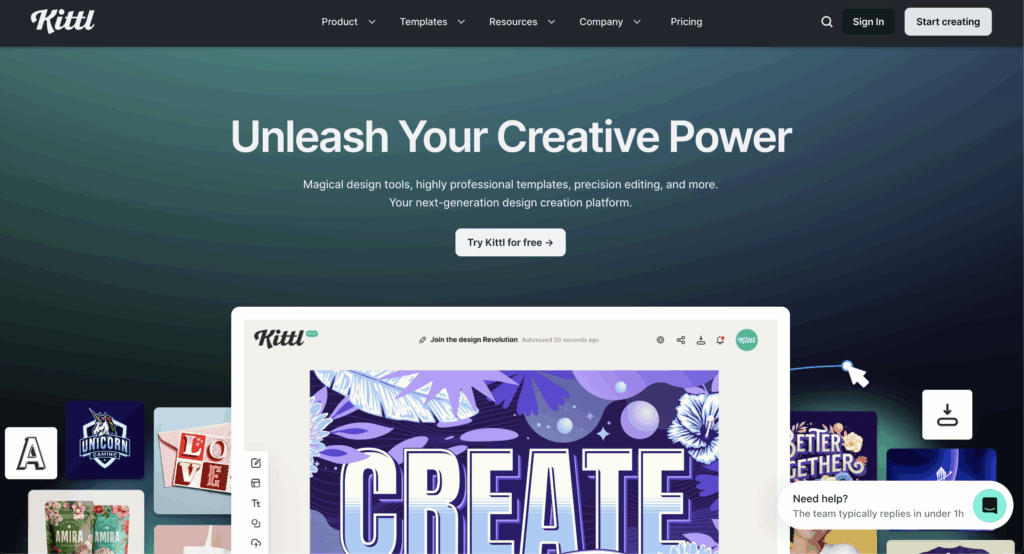
Kittl is an AI-driven design platform that specializes in vector art, typography, and print-ready graphics. It’s particularly strong for merchandise designers, print-on-demand businesses, and creative entrepreneurs.
Key Features
- AI-generated vector graphics and text effects.
- Ready-made templates for posters, apparel, and labels.
- Customizable typography options.
- Commercial-use licensing for print.
Pros
- Tailored for print-on-demand businesses.
- Excellent font and vector support.
- Affordable pricing compared to Adobe Illustrator.
Cons
- Not ideal for UI/UX design.
- Limited stock photography compared to Canva.
Best Business Use Cases
- Print-on-demand sellers designing t-shirts, mugs, posters, and stickers.
- Small creative shops making labels and packaging.
- Influencers selling branded merchandise.
Pricing
Free plan available; Pro plan from $10/month.
10. MidJourney
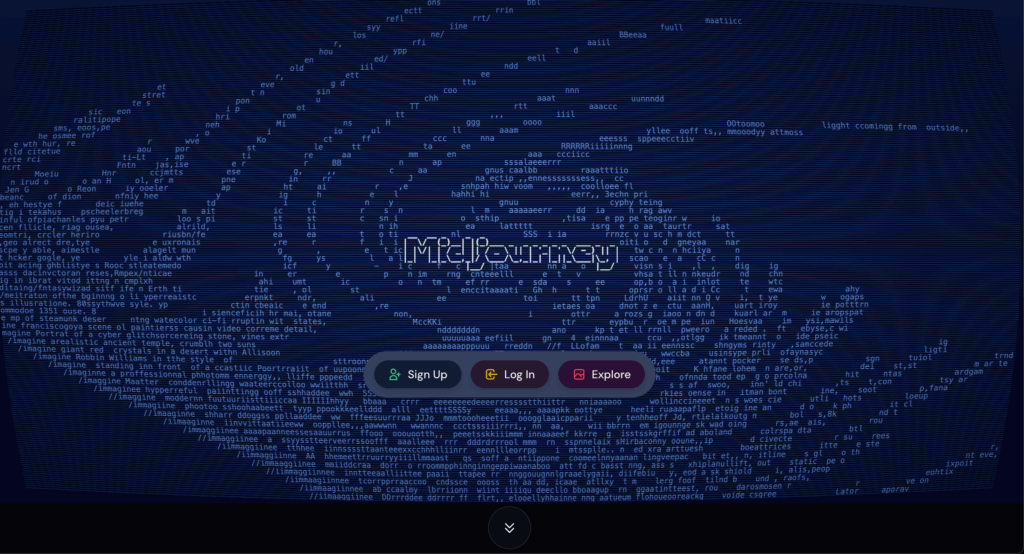
MidJourney is one of the most popular AI art generators, known for producing highly artistic and surreal imagery. Unlike Canva or Figma, it’s not about practical layouts; it’s about pushing the boundaries of visual creativity. Businesses use MidJourney to generate unique visuals for marketing, concept art, and campaigns.
Key Features
- Text-to-image AI with advanced prompt controls.
- Artistic rendering styles (realism, anime, fantasy, abstract).
- Iterative refinements to perfect outputs.
- Large community sharing prompt tips and art.
Pros
- High-quality, artistic visuals.
- Huge community for inspiration.
- Flexible prompt control.
Cons
- Runs on Discord (less intuitive for business use).
- Licensing for commercial projects requires higher tiers.
Best Business Use Cases
- Marketing campaigns needing bold, unique visuals.
- Creative agencies generating concept art and mood boards.
- Entertainment companies designing posters and covers.
Pricing
Plans start at $10/month; higher tiers allow commercial use.
11. DALL·E 3 (by OpenAI)
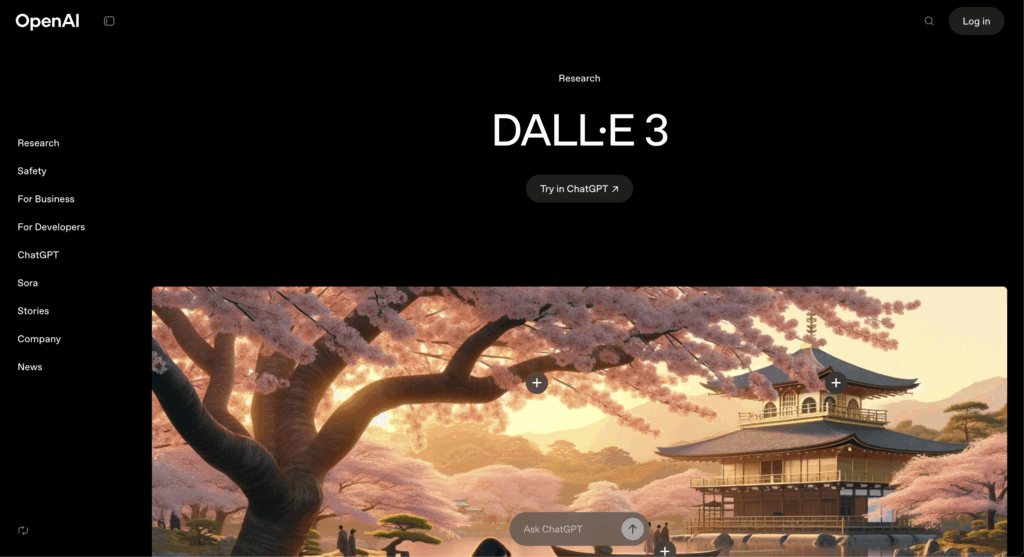
DALL·E 3 is OpenAI’s advanced text-to-image generator, integrated directly into ChatGPT. Unlike earlier versions, DALL·E 3 interprets prompts with remarkable accuracy and generates high-quality images that can be used for marketing, illustration, or product visualization. The integration with ChatGPT means you can refine images conversationally — making it easier for businesses to generate exactly what they need.
Key Features
- Converts natural language prompts into visuals.
- Inpainting: edit parts of an image with natural instructions.
- Strong integration with ChatGPT for iterative refinement.
- Generates illustrations, concept art, and marketing graphics.
Pros
- Extremely easy to use.
- Accurate interpretation of complex prompts.
- Great for quick creative assets.
Cons
- May produce inconsistent quality without detailed prompts.
- Licensing policies need careful attention for commercial projects.
Best Business Use Cases
- Marketing agencies creating campaign visuals.
- E-commerce brands generating product mockups.
- Startups needing fast, creative illustrations for blogs and websites.
Pricing
Included in ChatGPT Plus subscription at $20/month.
12. NightCafe
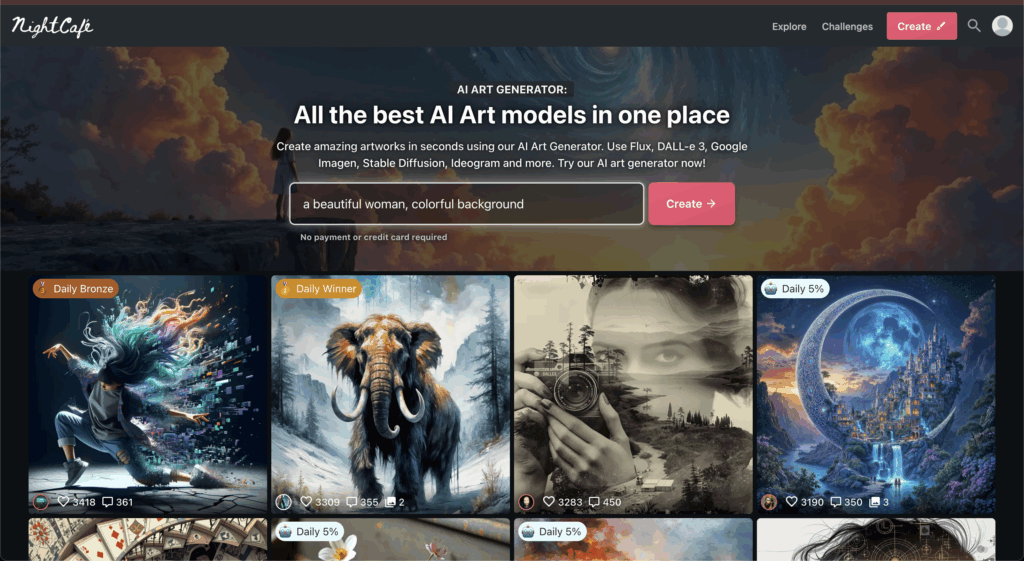
NightCafe is an AI-powered art generator that offers multiple styles and algorithms to create unique visuals. It’s community-driven, meaning users share prompts, styles, and outputs — making it a great place for inspiration. NightCafe is best suited for businesses or creators who need stylized, artistic images rather than polished branding assets.
Key Features
- Text-to-art generation in multiple styles (oil, anime, pixel, etc.).
- Daily free credits for casual users.
- Community gallery for prompt inspiration.
- Bulk creation for businesses scaling visuals.
Pros
- Wide variety of artistic styles.
- Active community for learning prompt techniques.
- Affordable entry with free credits.
Cons
- Not as polished as MidJourney for high-end outputs.
- Less suited for commercial branding assets.
Best Business Use Cases
- Indie game developers creating background art.
- Creative agencies experimenting with campaign concepts.
- Artists generating inspiration or base images.
Pricing
Free tier available; paid plans start at $9.99/month.
13. DeepAI
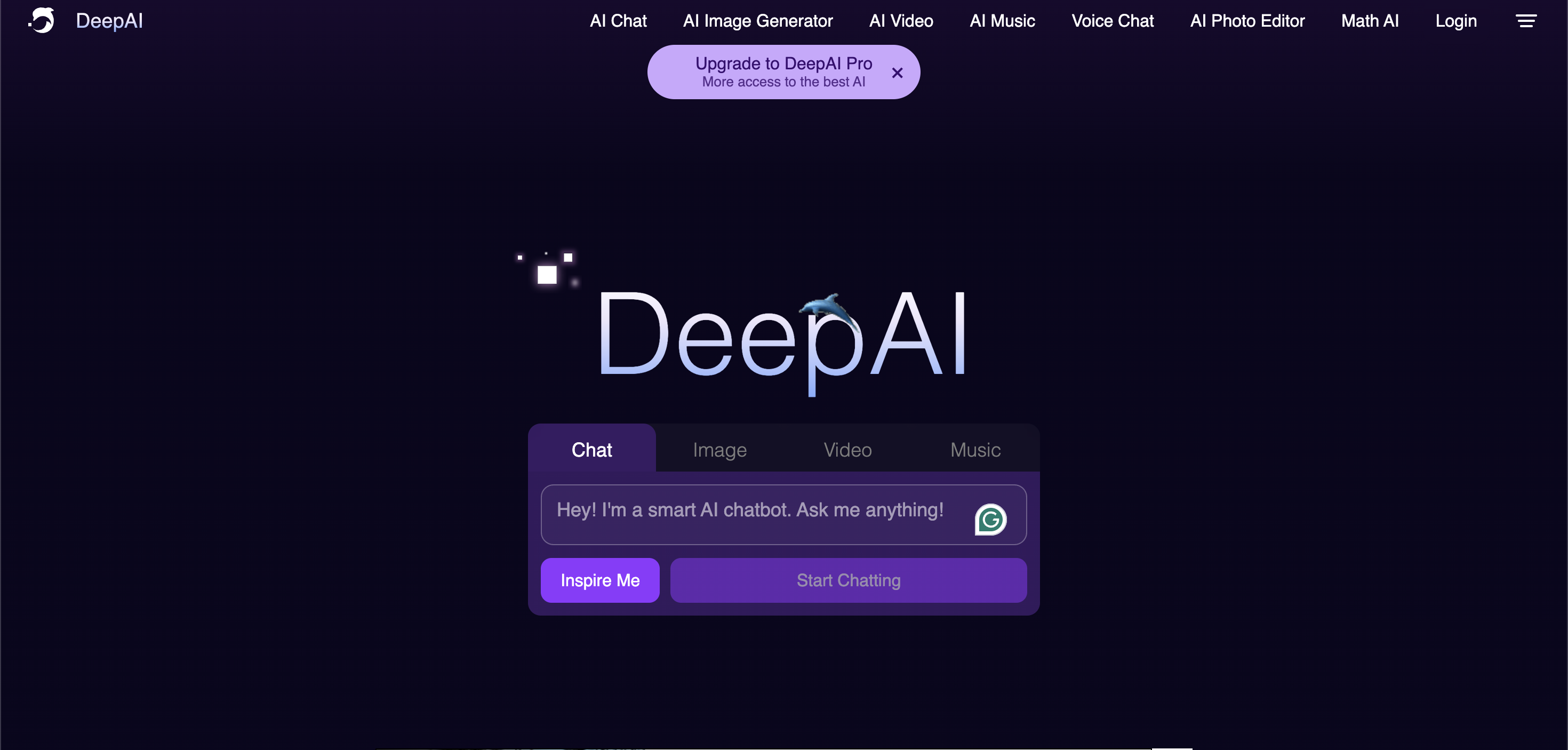
DeepAI is a versatile AI design platform offering tools for text-to-image, image editing, and AI-generated art. It aims to provide affordable access to AI visuals for individuals and businesses. While not as visually refined as MidJourney or DALL·E, it’s an excellent budget-friendly choice for rapid prototyping.
Key Features
- Text-to-image generation.
- Style-based filters for unique looks.
- AI-powered image editing.
- API access for developers.
Pros
- Affordable and accessible.
- Variety of filters and effects.
- Great for experimentation.
Cons
- Lower image quality compared to premium tools.
- Not ideal for polished commercial assets.
Best Business Use Cases
- Startups prototyping ad creatives.
- Developers integrating AI design via API.
- Educators demonstrating AI in creative projects.
Pricing
Free limited version; pro plans from $5/month.
14. VistaCreate (formerly Crello)

VistaCreate is a Canva-style AI design tool offering templates, branding features, and quick visual generation. Owned by VistaPrint, it’s designed for SMBs and entrepreneurs who want affordable, scalable design solutions.
Key Features
- AI-powered design templates.
- Brand kits for consistent visuals.
- Stock image and video integration.
- Social media content scheduler.
Pros
- Budget-friendly alternative to Canva.
- Wide library of templates.
- Great for marketing teams.
Cons
- AI features are less advanced than Canva’s Magic Design.
- Templates may feel generic without customization.
Best Business Use Cases
- Small businesses creating flyers, banners, and posters.
- Freelancers producing content quickly for clients.
- E-commerce shops generating product promos.
Pricing
Free plan available; Pro plan at $10/month.
15. Jasper Art
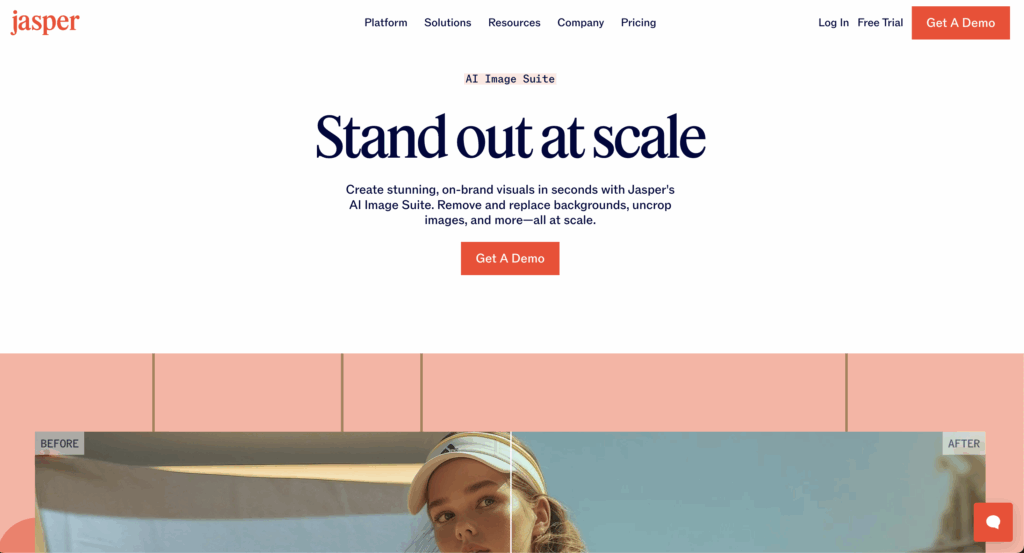
Jasper is known for its AI writing assistant, but it also offers Jasper Art, an AI-powered image generator. It’s ideal for marketing teams that want both copywriting and visuals from one platform. Jasper Art is prompt-driven and focuses on generating on-brand images for campaigns.
Key Features
- Text-to-image creation with brand customization.
- Integration with Jasper’s writing assistant.
- Multiple style and format options.
- Commercial-use licensing included.
Pros
- Combines text + visuals in one platform.
- Tailored for marketers.
- Easy integration with campaigns.
Cons
- Not as visually advanced as MidJourney.
- Requires Jasper subscription.
Best Business Use Cases
- Marketing agencies creating blog visuals and ads.
- Content teams generating on-brand illustrations.
- SMBs running lean content marketing operations.
Pricing
Included in Jasper subscription; starts at $49/month.
Business Use Cases of AI Design Tools
AI design tools are not just novelties — they solve real business problems. Here are the most impactful use cases:
1. Branding & Identity Creation
Startups and small businesses often lack the budget for full-scale design agencies. Tools like Looka or Brandmark enable them to create logos, color palettes, and consistent branding packages within hours. This gives new businesses a professional presence from day one.
Example: A local fitness studio used Looka to design a sleek logo and social media templates. This consistency helped them gain credibility against larger competitors.
2. Marketing Campaigns & Ads
Marketers must constantly produce fresh, eye-catching creatives for Facebook, Instagram, YouTube, and Google Ads. AI tools like Canva, Designs.ai, and VistaCreate allow them to generate multiple variations for A/B testing at scale.
Example: An e-commerce brand used Canva’s Magic Resize to repurpose a single campaign into 15 ad sizes, saving days of manual design.
3. UI/UX Prototyping
For SaaS companies and app startups, time-to-market is everything. AI tools like Figma AI and Uizard can generate wireframes and prototypes instantly, reducing the early design stage from weeks to hours.
Example: A fintech startup used Figma AI to create a full mobile dashboard mockup to pitch investors — before writing a single line of code.
4. E-commerce & Print-on-Demand
Merchandise designers and online sellers rely on tools like Kittl and MidJourney to create t-shirt graphics, mug prints, and poster designs. These assets are often ready for commercial use.
Example: A POD store used Kittl to launch 50 unique designs in under a week, scaling sales without hiring multiple designers.
5. Corporate Training & Communication
AI avatars from Synthesia and HeyGen (if included) let HR and training teams produce onboarding videos, internal guides, and multilingual resources without filming staff or hiring actors.
Example: A global SaaS firm produced training videos in 10 languages using AI avatars, saving $50,000+ on production costs.
Limitations of AI Design Tools
While AI design platforms are powerful, they are not perfect. Businesses must be aware of:
- Generic Outputs – Without customization, AI results can look too similar to other brands.
- Copyright & Licensing Issues – Not all AI-generated designs are legally protected; businesses must check terms of use.
- Lack of Original Creativity – AI recombines existing data; it doesn’t innovate in the way human designers can.
- Human Touch Still Needed – Final polish, emotional resonance, and storytelling still come from human creativity.
SEO Tip: Emphasizing these limitations makes your article more trustworthy and authoritative, increasing Google ranking signals.
The Future of AI in Design
The next 5 years will see AI move from simple template generation to true creative collaboration. Here’s what’s ahead:
- AI Co-Pilots for Designers: Designers will spend less time on repetitive edits and more on strategy and storytelling.
- Personalized Branding: AI will create logos, color palettes, and visuals that adapt dynamically to each audience segment.
- Integration with AR/VR & 3D Design: Tools like Stable Diffusion are already experimenting with 3D modeling and immersive design.
- Ethical AI Design: Expect frameworks around originality, copyright, and fair use to strengthen as AI adoption grows.
Example: Imagine logging into Canva in 2030 and seeing a real-time AI brand assistant that knows your industry, goals, and audience — and generates fully optimized campaigns instantly. That’s where we’re heading.
FAQs about AI Design Tools
Q1. What is the best AI design tool for beginners?
Canva, VistaCreate, and Looka are beginner-friendly with minimal learning curve.
Q2. Which AI design tools are free?
AutoDraw, Khroma, and limited versions of Canva, Kittl, and NightCafe are free.
Q3. Will AI design tools replace human designers?
Not entirely. AI automates production, but human designers bring creativity, emotion, and brand storytelling.
Q4. What’s the best AI design tool for businesses?
For branding: Looka / Brandmark.
For marketing: Canva / Designs.ai.
For UI/UX: Figma AI / Uizard.
Q5. Can AI legally create logos?
Yes, but check licensing. Some platforms (Looka, Brandmark) provide commercial rights, while others (MidJourney, DALL·E) require specific licenses.
Conclusion
The rise of AI design tools is transforming how businesses create, scale, and manage their branding and creative assets. From Canva’s easy Magic Design AI to Adobe Firefly’s pro-grade features, Figma’s UI prototyping, and Looka’s affordable branding kits, there is an AI tool for every use case.
For businesses:
- Startups should use Looka or Canva for fast branding.
- Marketers will thrive with Designs.ai, VistaCreate, and Jasper Art.
- UI/UX teams need Figma AI and Uizard.
- Creative agencies can experiment with MidJourney and DALL·E for campaign visuals.
The bottom line: AI design tools aren’t replacing creativity — they’re amplifying it. The businesses that adopt AI in their design workflows today will enjoy faster campaigns, stronger branding, and a clear competitive edge tomorrow.
👉 Final SEO CTA: If you’re looking for the best AI design tools in 2025, start experimenting with one today. The sooner you integrate AI into your creative workflow, the sooner you’ll outpace competitors who are still stuck with traditional, slow design methods.

